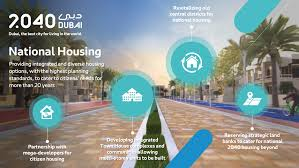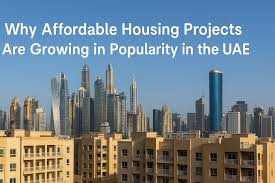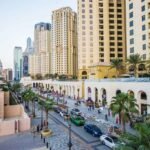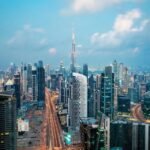Now Reading: Affordable Housing Initiatives in the UAE: Building Inclusive Communities for 2025
-
01
Affordable Housing Initiatives in the UAE: Building Inclusive Communities for 2025
Affordable Housing Initiatives in the UAE: Building Inclusive Communities for 2025

Table of Contents
The United Arab Emirates (UAE) has long been recognized for its opulent skylines and luxurious living standards. However, as the nation progresses into 2025, there is a notable shift towards addressing the housing needs of its diverse population, particularly middle-income citizens and expatriates. This transformation is driven by a series of strategic government initiatives and innovative projects aimed at making quality housing more accessible and affordable.

1. Government-Backed Housing Projects: A Commitment to Citizens
In January 2025, His Highness Sheikh Mohammed bin Rashid Al Maktoum approved a series of housing projects worth AED 5.4 billion, aimed at providing 3,004 new homes for Emirati citizens across various areas of Dubai. These projects include a mix of housing loans and grants, with developments in Latifa City, Al Yalayis 5, Wadi Al Amardi, Al Awir 1, Makan area of Hatta, Oud Al Muteena, and rural areas of Dubai. This initiative underscores the government’s commitment to ensuring that its citizens have access to affordable and quality housing options.
2. Smart Zoning and Regulatory Reforms: Facilitating Affordable Housing Development
Dubai Municipality’s “Smart Zoning Initiative,” introduced in 2024, has revolutionized land use regulations by creating dedicated affordable housing corridors along major transportation routes. These zones benefit from increased Floor Space Index (FSI) allowances, permitting developers to construct higher-density residential projects while maintaining strict quality standards. Additionally, recent amendments to the Dubai Property Law have introduced mandatory inclusionary zoning requirements, stipulating that developments exceeding 200 units must allocate a minimum of 15% to affordable housing. These regulatory updates have resulted in a 25% reduction in the average cost per square foot in designated affordable housing zones, making housing more accessible to a broader segment of the population.
3. Sustainable and Smart Housing Solutions

The UAE is increasingly integrating sustainability into its affordable housing projects. For instance, Sharjah Sustainable City, valued at around AED 2 billion, incorporates several sustainability-focused features, including rooftop solar panels, 100% wastewater recycling for landscape irrigation, and infrastructure for electric vehicles and autonomous shuttles. These initiatives aim to reduce utility bills by up to 50% and promote a low-carbon lifestyle, aligning with the UAE’s Net Zero 2050 initiative.
4. Public-Private Partnerships: Collaborative Housing Development
To meet the growing demand for affordable housing, Dubai has adopted a public-private partnership (PPP) model, allowing collaboration between the government and private real estate developers. This approach increases housing supply while maintaining quality and affordability. The government offers incentives such as reduced registration fees and long-term installment plans to ease the financial burden for buyers and developers. This collaborative approach has led to the development of numerous affordable housing units across the emirate.
5. Community Engagement and Empowerment
Community engagement has become a cornerstone of affordable housing initiatives in the UAE. Programs that involve residents in community management and maintenance have led to 40% lower maintenance costs and 25% higher resident satisfaction rates compared to traditionally managed developments. These initiatives have created self-sustaining ecosystems within affordable housing communities, with over 65% of basic services now managed through community cooperation. Additionally, participating households report average annual savings of AED 15,000 through group purchasing programs, shared services, and cooperative maintenance arrangements.
6. Innovative Financing Models: Making Homeownership Accessible

Innovative financing models have been introduced to make homeownership more accessible. For example, rent-to-own schemes allow first-time purchasers to rent a home while paying a percentage of their monthly rent towards the property’s ownership. Residents are given the option to convert their rental agreement into a mortgage and become homeowners if they fulfill specific criteria. This approach helps individuals who struggle to save for a sizable down payment overcome this barrier.
7. Digital Transformation in Housing Administration
The digitalization of Dubai’s housing sector has emerged as a crucial enabler of affordable housing initiatives. The launch of the “Dubai Housing Digital Platform” in 2024 has created a unified ecosystem for all housing-related services, from application processing to property management. This platform has resulted in a 60% reduction in processing times for affordable housing applications. Advanced technologies such as blockchain have been integrated into property registration systems, ensuring transparent and efficient transfer of ownership while reducing transaction costs by an average of 35%.
Challenges and Forward-Looking Strategies
Despite these advancements, challenges remain in the pursuit of affordable housing in the UAE. Rising demand, inflation, land scarcity, and regulatory barriers continue to pose obstacles. However, the UAE’s proactive approach, characterized by innovative policies, sustainable practices, and community involvement, positions the nation on a path toward achieving its housing goals. Continued collaboration between government entities, private developers, and communities will be essential in overcoming these challenges and ensuring that affordable housing remains a reality for all residents.
Conclusion
The UAE’s commitment to affordable housing is evident in its comprehensive and forward-thinking initiatives. Through strategic planning, sustainable development, and community engagement, the nation is laying the foundation for inclusive and resilient communities. As these projects continue to evolve, they not only address the immediate housing needs but also contribute to the long-term social and economic stability of the UAE.
WATCH MORE: https://www.instagram.com/reel/DF7tzMuNk7A/
READ MORE: Government Initiatives and Infrastructure Development: 7 Key Projects Fueling National Growth






















